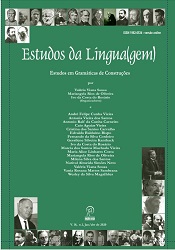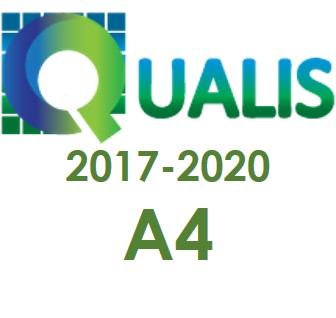Construções hipotáticas oracionais aditivas de extensão (Extending additive hypotactic clausal constructions)
DOI:
https://doi.org/10.22481/el.v18i1.6099Palavras-chave:
Adição. Hipotaxe. Extensão.Resumo
Este artigo investiga as propriedades formais e funcionais das construções hipotáticas oracionais aditivas de extensão (CHOAE) instanciadas pelo conector além de e suas relações com construções aparentadas. A pesquisa fundamenta-se nos pressupostos teórico-metodológicos da Linguística Funcional Centrada no Uso. Os dados, extraídos do Corpus do Português e de outras fontes, em recorte sincrônico, são analisados pelo viés qualitativo e quantitativo. Os resultados demonstram que o conector além de é recrutado para diversas construções da língua portuguesa, desde usos mais concretos e espaciais até usos mais abstratos destinados à conexão de sintagmas e orações em língua portuguesa. Nessa grande gama de usos, as CHOAE revelam-se como construções que pertencem ao domínio da hipotaxe de extensão (em termos formais) e adjungem a noção de adição à ideia de “ultrapassamento” (em termos funcionais).
Downloads
Referências
BECHARA, E. Gramática Escolar da língua portuguesa. Rio de Janeiro: Lucerna, 2003.
BYBEE, J. Language, usage and cognition. Cambridge: Cambridge University Press, 2010.
CASTILHO, A. T. Nova gramática do Português Brasileiro. São Paulo: Contexto, 2010.
CUNHA, C.; CINTRA, L. Nova Gramática do Português Contemporâneo. Rio de Janeiro: Nova Fronteira, 2001.
CROFT, W. Toward a social cognitive linguistics. In: EVANS, V.; POURCEL, S. (Org.). New directions in cognitive linguistics. Amsterdam: John Benjamins, 2009.
DECAT, M. B. N. A articulação hipotática adverbial no português em uso. In: ______ et al. (Org.) Aspectos da Gramática do Português: uma abordagem funcionalista. Campinas: Mercado das Letras, 2001.
FURTADO DA CUNHA, M. A.; BISPO, E. B.; SILVA, J. R. Linguística Funcional Centrada no Uso: conceitos básicos e categorias analíticas. In: CEZARIO, M. M.; FURTADO DA CUNHA, M. A. (Org.) Linguística centrada no uso: uma homenagem a Mário Martelotta. Rio de Janeiro: Mauad-Faperj, 2013.
GOLDBERG, A. Constructions: a construction approach to argument structure. Chicago: The University of Chicago Press, 1995.
_______. Constructions at work: the nature of generalization in language. Oxford: Oxford University Press, 2006.
HALLIDAY, M. A. K. An introduction to functional grammar. Great Britain: Hodder Arnold, 2004.
HOPPER, P.; TRAUGOTT, E. C. Grammaticalization. Cambridge: Cambridge University Press, 1997.
LANGACKER, R. W. Complex Sentences. In:____. Cognitive grammar: a basic introduction. Oxford: Oxford University Press, 2008.
LENKER, U. Argument and rhetoric adverbial connectors in the history of English. Berlin/New York: Walter de Gruyter, 2010.
MONTOLIO, E. Conectores de la lengua escrita. Barcelona: Editorial Planeta, 2001.
NEVES, Maria Helena de Moura. Texto e gramática. São Paulo: Contexto, 2006.
OLIVEIRA, Taísa Peres. A hipotaxe de adição. Revista do GEL, São Paulo, v. 9, n. 2, p. 25-45, 2012. Disponível em https://revistadogel.emnuvens.com.br/rg/article/view/2
ROCHA LIMA, C. H. Gramática Normativa da Língua Portuguesa. Rio de Janeiro: José Olympio, 1999
ROSÁRIO, I. C. Construções aditivas - uma análise funcional. In: OLIVEIRA, M. R.; _______. (Org.). Pesquisa em linguística funcional: convergências e divergências. Niterói - RJ: Leo Christiano Editorial, 2009.
_______. Construções correlatas aditivas em perspectiva funcional. Niterói, RJ: Editora EDUFF, 2018a.
_______. Construções correlatas aditivas são estruturas de coordenação? In: FURTADO DA CUNHA, M. A.; BISPO, E. B.; SILVA, J. R. (Org.) Variação e mudança em perspectiva construcional. 1ª ed. Natal - RN: EDUFRN, 2018b, v. 1, p. 210-250. Disponível em https://repositorio.ufrn.br/jspui/handle/123456789/25293
_______. Reflexões sobre o critério da (in)dependência no âmbito da integração de orações. Línguas & Letras (Online), v. 17, p. 252-272, 2016. Disponível em http://e-revista.unioeste.br/index.php/linguaseletras/article/view/12744/
______; OLIVEIRA, M. R. Funcionalismo e Abordagem Construcional da Gramática. Alfa, São Paulo, 60 (2): 233-259, 2016. Disponível em http://www.scielo.br/pdf/alfa/v60n2/1981-5794-alfa-60 -2-0233.pdf
TEIXEIRA, A. C. M.; ROSÁRIO, I. C. O estatuto da microconstrucionalização no quadro da mudança linguística. Revista Linguística, v. especial, p. 139-151, 2016. Disponível em https://revistas.ufrj.br/index.php/rl/article/view/5444/4036
TOMASELLO, M. The new psychology of language. New York, L. Erlbaum, 1998.
TRAUGOTT, E, C; TROUSDALE, G. Constructionalization and constructional changes. Oxford, Oxford University Press, 2013.
Downloads
Publicado
Como Citar
Edição
Seção
Licença
Autores que publicam em Estudos da Língua(gem) concordam com os seguintes termos:
Estudos da Língua(gem) mantém os direitos autorais das contribuições publicadas e disponibiliza seu conteúdo gratuitamente por meio do portal. Autores têm permissão e são estimulados a publicar e distribuir seu trabalho online em repositórios institucionais ou na sua página pessoal, com reconhecimento de autoria e créditos de publicação inicial nesta revista, indicando endereço online.












